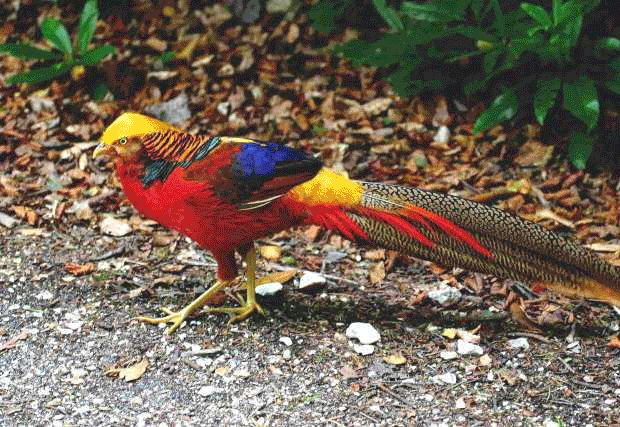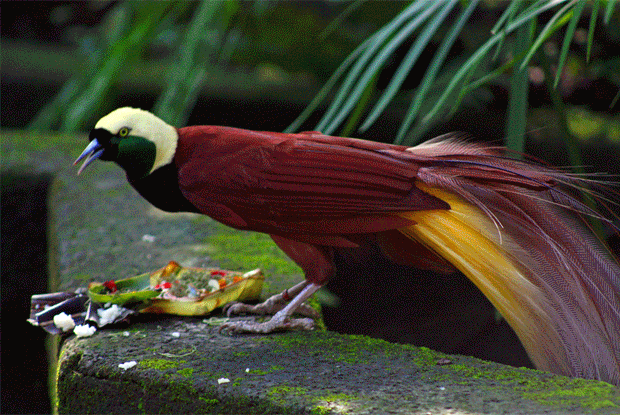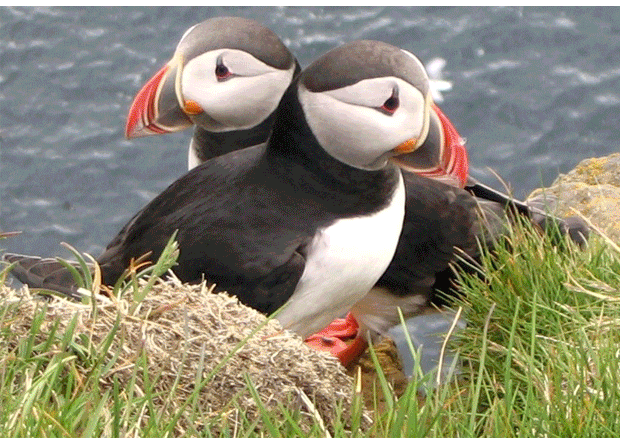|
Only a few animals on earth are able to fly. But none
of them are more powerful or skillful than the birds. Birds are the only
creatures that have feathers. Their feathers help them to fly and keep
warm. Some birds use their brightly colored feathers for display
especially during courtship. In many cases, their fascinating colors are
the reason many of their friends become endangered or extinct as they
become victims of human hands for bird trade.
|
 |
The Rainbow Lorikeet, (Trichoglossus haematodus) is a species of
Australasian parrot found in Australia, eastern Indonesia (Maluku and
Western New Guinea), Papua New Guinea, New Caledonia, the Solomon
Islands and Vanuatu. In Australia, it is common along the eastern
seaboard, from Queensland to South Australia and northwest Tasmania. Its
habitat is rainforest, coastal bush and woodland areas. Several taxa
traditionally listed as subspecies of the Rainbow Lorikeet are
increasingly treated as separate species. There is little to visually
distinguish between the sexes, however to a keen observer of their
coloring and behavior, their dimorphism is readily apparent.
|
 |
A truly magnificent sight, the Golden or Chinese Pheasant is
another type of bird that catches the eye with a wonderful display of
color. These are gamebirds, native to western China, although they have
been bred in other countries like the UK, and are unmistakably lovely
with a golden crest, rump and bright red body. When showing off to
attract a mate, the male spreads his deep orange 'cape,' which looks
just like a black and orange fan covering everything except the bright
yellow eye. It is native to forests in mountainous areas of western
China, but feral populations have been established in the United Kingdom
and elsewhere.
|
 |
The resplendent quetzal is an aptly named bird that many consider
among the world's most beautiful. These vibrantly colored animals live
in the mountainous, tropical forests of Central America where they eat
fruit, insects, lizards, and other small creatures. Unfortunately, these
striking birds are threatened in Guatemala and elsewhere.
|
 |
The Hoopoe, a colorful bird that is found across Afro-Eurasia, is
notable for its distinctive 'crown' of feathers. It is the only extant
species in the family Upupidae. One insular species, the Giant Hoopoe of
Saint Helena, is extinct, and the Madagascar subspecies of the Hoopoe is
sometimes elevated to a full species. Like the Latin name upupa, the
English name is an onomatopoetic form which imitates the cry of the
bird.
|
 |
The Birds of Paradise are members of the family Paradisaeidae of
the order Passeriformes. The majority of species in this family are
found on the island of New Guinea and its satellites, with a few species
occurring in the Moluccas and eastern Australia. It's likely that you
will only see them on film, though, because they mostly live in
inaccessible, dense rainforest habitats.
|
 |
The Atlantic Puffin (Fratercula arctica) is a seabird species in
the auk family. It is a pelagic bird that feeds primarily by diving for
fish, but also eats other sea creatures, such as squid and crustaceans.
Its most obvious characteristic during the breeding season is its
brightly colored bill. Also known as the Common Puffin, it is the only
puffin species which is found in the Atlantic Ocean. The curious
appearance of the bird, with its large colorful bill and its striking
piebald plumage, has given rise to nicknames such as '"clown of the
ocean" and "sea rooster." The Atlantic Puffin is the provincial bird for
the Canadian province of Newfoundland and Labrador.
|
 |
The Lear's Macaw (Anodorhynchus leari), also known as the Indigo
Macaw, is a large, all blue Brazilian parrot that is a member of a large
group of Neotropical parrots known as macaws. It was first described by
Charles Lucien Bonaparte in 1856. The Lear's Macaw is 70–75 cm. (28–30
in.) long and weighs around 950 g. (2.1 lb.). It is metallic blue with a
faint, often barely visible tinge of green, and a yellow patch of skin
at the base of the heavy, black bill. This macaw is rare with a highly
restricted range.
|
 |
Stork-billed Kingfishers eat mainly fish, using their large heavy
bills effectively to catch and kill their prey. From their perch,
usually about 2-4 m. above the water, they will plunge into the water.
They also eat crabs, insects, frogs, mice, lizards, and birds, along
with their eggs. Prey is brought back and whacked senseless against the
perch. They usually hunt near freshwater and along coasts and mangroves,
particularly in habitats with suitable perches. Unlike the Collared,
Stork-billed Kingfishers are rarely found near urban areas.
|
 |
The male Northern Cardinal may be responsible for getting more
people to open up a field guide than any other bird. They're a perfect
combination of familiarity, conspicuousness, and style: a shade of red
you can't take your eyes off. Even the brown females sport a sharp crest
and warm red accents. Cardinals don't migrate and they don't molt into a
dull plumage, so they're still breathtaking in winter's snowy backyards.
In summer, their sweet whistles are one of the first sounds of the
morning.
|